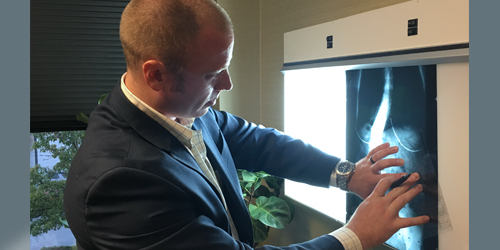
By Zachary Tempel, MD
If you or a loved one suffers from adult spinal deformity or scoliosis, you know that treatment can be very challenging.
When patients come to me with these complex problems, I tell them up front that it is crucial for me to understand everything I need to know about their spine before committing to a specific treatment plan. I want to understand where their pain is coming from and how it impacts their quality of life. I also want to understand their spine from a “global” perspective. I want to understand the problem areas within the context of the anatomy of their entire spine.
Not every patient with scoliosis or spinal deformity needs to undergo a complex spinal reconstruction. If the underlying problem is a disc herniation or instability at one or two levels, we can perform a smaller, targeted operation. At the same time, if we provide a targeted treatment without understanding the global spinal pathology, we are potentially putting a patient at risk for major problems down the road.
My first rule is that no one is allowed to sign up for deformity surgery on the first visit. Spinal deformity treatment is an extended process, and a patient is potentially embarking on a massive operation followed by a long recovery. I tell patients who face major surgery that you will be a patient for 3 months, and it will take 6 months for you to put the operation in your rearview mirror. It will take a full year for you to achieve the maximum medical benefit of the surgery.
Patients are also not allowed to schedule deformity surgery without having their support system present – typically one or more family members – during an office visit. If you are undergoing this surgery, your loved ones need to understand the magnitude of what lies ahead.
Diagnostics
After we have become acquainted, the next important step involves getting a thorough diagnosis. We will perform a myelogram, an invasive diagnostic test that uses x-rays and CT scans to examine the spinal canal. We will also order scoliosis x-rays – known as long-cassette x-rays — to document your spine’s stability and how the curve is changing over time. These 36-inch x-rays are taken while you are standing.
During this period, most patients will work with one of our physical medicine and rehabilitation specialists. These doctors, called physiatrists, treat patients conservatively and help them get by before surgery. They help figure out which parts of the deformity or pathology are responsible for various complaints. We may also have our patients work with physical therapists while their surgery is being planned.
Treatment
Surgery typically involves a combination of different approaches and techniques. Each technique chosen is based on the patient’s anatomy and the functionality of their spinal alignment. If the patient can be treated with minimally invasive techniques, the surgery may be performed in one day.
But if the treatment requires multiple approaches with an “open” approach through the back or an osteotomy – the careful cutting of bone – we will perform the surgery in stages over two days.
Staged operations are the gold standard in major spinal deformity surgery. Operating in this way dramatically reduces the amount of surgery performed in one day, minimizes blood loss, reduces the length of time a patient spends under anesthesia, and is easier on the surgeons. Staged surgeries are generally performed with 2 surgeons or with a surgeon and an experienced surgical provider.
After the first stage, the patient will be asked to stand up and walk around. We will then order a new set of scoliosis x-rays to measure various angles and take a new look at the alignment. In some cases, the first operation will have achieved such a robust correction, and symptoms will have improved so dramatically, that we are able to perform a less invasive surgery the second day.
Recovery
I like to say that it takes a village to raise a patient who has complex spinal deformity surgery. I say that wholeheartedly because surgery is only half the battle. The rest of the battle is the recovery.
Recovery starts in the intensive care unit, where patients stay for 3 or 4 days. Here, critical care nurses and medical technicians monitor blood loss and fluid balance. From the ICU, patients are transferred to a standard hospital room, where they continue their recovery. Depending on their situation, they may then go to a rehabilitation facility, where they benefit from continuing support while their body heals.
Physical therapy is likely to continue for several months. As I mentioned earlier, it will take a year for an individual to achieve his or her full medical benefit from complex spinal deformity surgery.
But the rewards are significant for the patient, for the family, and for the surgery team. I can tell you there is nothing more gratifying than to see a patient whose life has been transformed by spinal deformity surgery. The whole process can be arduous, both for the patient and the surgeon. But it is a truly emotional experience to see a patient who was once severely disabled from a crippling deformity come to clinic with the ability to stand upright with a renewed sense of pride and happiness.
As I often say to patients, this is a team endeavor, and we are all on the same team. If we stick to that philosophy, then everyone wins.
Zachary Tempel, MD, is a neurosurgeon with Mayfield Brain & Spine.